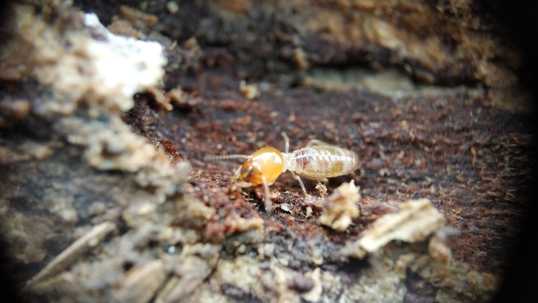Drywood termites and subterranean termites are both termites, but their habitats differ from each other and have different infestation methods. To understand the differences between drywood termites vs. subterranean termites, we will take a more in-depth look at their appearances, nesting habits, and their signs of infestation.
Drywood Termite
Drywood termites can be between ¼ inch of an inch to 3/8 of an inch long. They have short legs, a straight antennae, and a thick waist. The color of drywood termites can be white or brown and sometimes even translucent. Drywood termites are winged for a brief time when they are searching for a new nesting location. Once they have found a new home, they shed their wings.
Subterranean Termites
Smaller in size, subterranean termites can range in size between 1/8 of an inch to 3/8 of an inch in length. At the same time, there are many subspecies with appearances that vary. For instance, the soldier subterranean termites are on the larger side and have yellowish-brown heads. The alates, the new kings and queens, are winged, fly, and are dark brown or black.
Nesting Habits
Above Ground
Drywood termites typically live in areas of high humidity. They need water to survive, and they extract the water from the wood in which they create their colony. Drywood termites live in dry forest areas, which is above the ground. They get all their moisture from the wood they digest. Because of this, they do not need contact with the soil. They typically live in structures such as wooden roof shingles, siding, and furniture. Drywood termites are winged for a short time when they are searching for a new home. Once they have found a piece of wood, they shed their wings and find a small hole or crack to get inside. Once inside, they eat along the wood grain, creating their colony along the way. After about a year, a drywood colony can have grown up to 1,000 members.
Under Ground
Subterranean termites are the most common types of termites; found across the globe. Unlike drywood termites, subterranean termites make their nests underground and create mud tubes. They require moisture to survive and get their source of water from the soil. The mud tubes that they produce are a mixture of small pieces of mud and wood. These tubes provide the subterranean termites with the environment that allows them to travel safely between a wood food source and their nest. Find subterranean termite tubes along the foundation of a property, where the termites enter the structure from the ground.
Signs of Infestation
Wings
The infestations for drywood termites vs subterranean termites differ from each other. Drywood termites can live in a nest for years before someone notices them, but they do leave behind some evidence of their infestation. When drywood termites find a piece of wood that is suited to their nesting needs, they will shed their wings before entering the wood structure. A sign of drywood termite is a pile of these discarded wings near the entry they have inhabited. Also, While drywood termites eat along the wood grain, they create a waste product called frass. Frass looks like small roundish wood, the same color of the wood they are nesting in.
Nesting
In contrast, drywood termites do not need frass, and because of this, they push it out of a small hole in the lumber. For example, a noticeable pile of granular pellets in the wood’s color they have eaten. Since drywood termites hide within a piece of wood, it may appear to look ordinary on the outside. Another sign of drywood termites is to tap upon the structure. It will make a hollow, dull sound because the inside has been eaten away and made into a space for their colony, which after years can be as big as 2,500 members.
Mud Tubes
The telltale sign of a subterranean termites infestation is their distinctive mud tubes. Subterranean termites always stay hidden from our view, either underground, in their mud tubes, or within the wood. Because of this, they are successful in being undetected as they invade a structure. Their point of attack is usually from the soil along the foundation of a structure. They will enter through cracks in the slab, conduits plumbing connections, and joints in the building. For example, another sign of a drywood termite infestation is swarmers. Because, unlike their termite cousin, subterranean termites have a group that stayed winged and will fly in and out of their mud tubes. The final sign of a subterranean termite nest is wood damage. When subterranean termites have infested a piece of wood, it will have blisters or dark areas, but this sign isn’t as noticeable because they eat along the wood grain.

